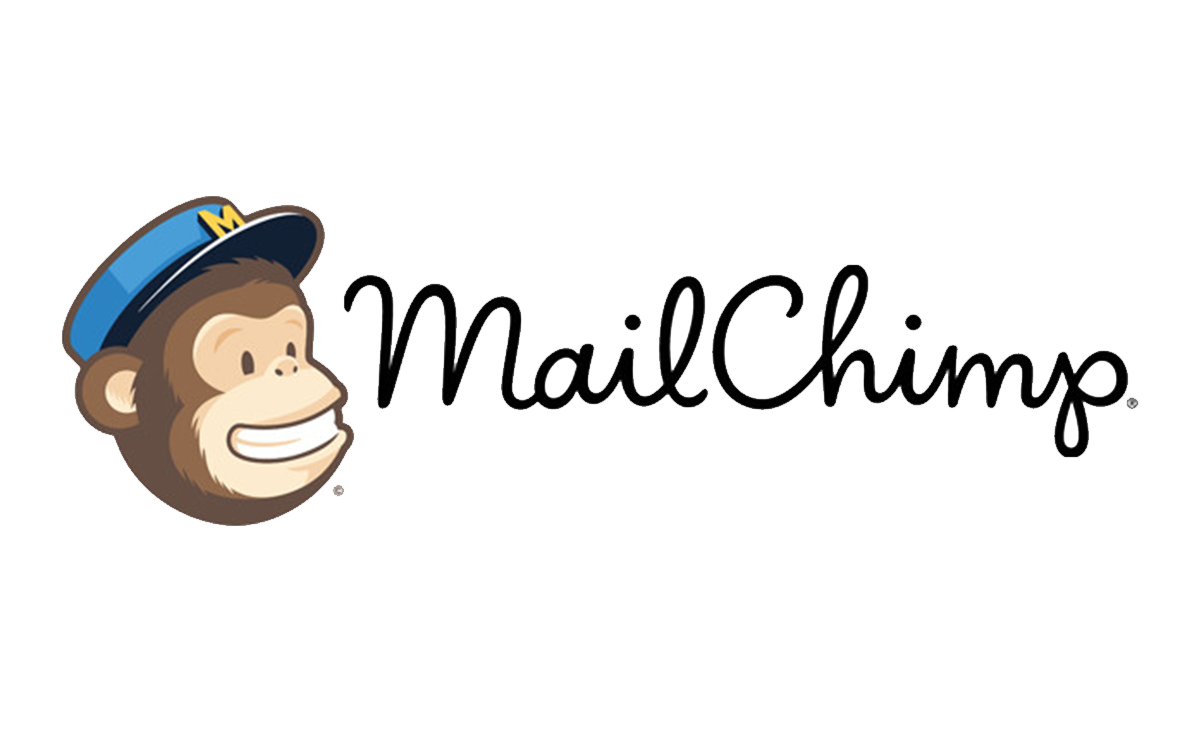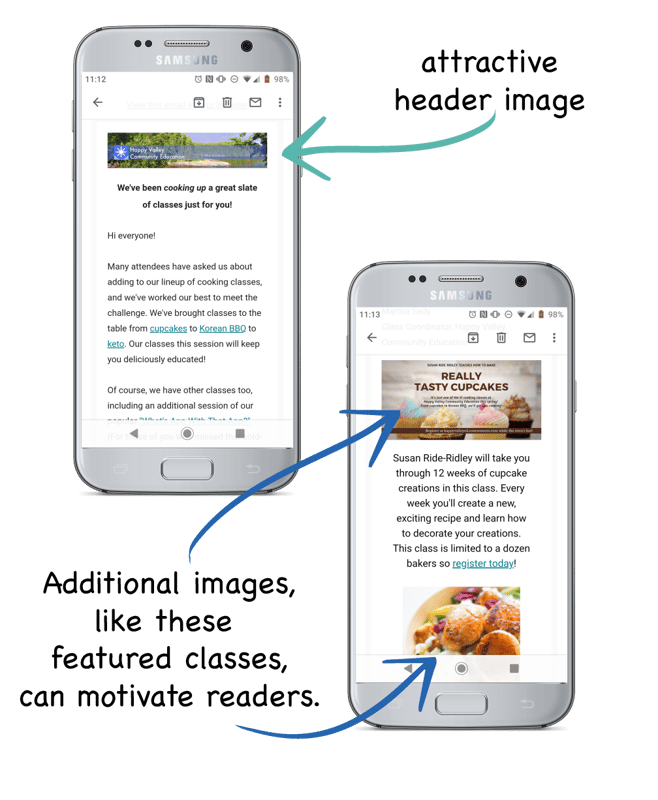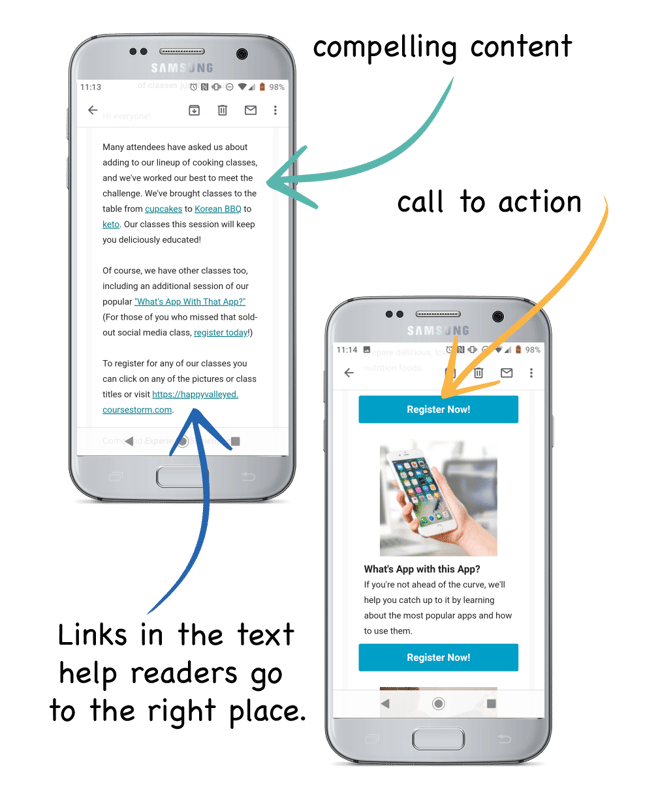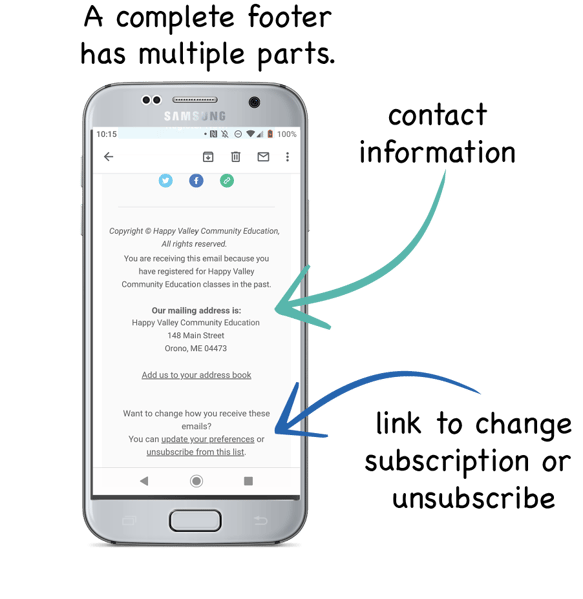When filling classes is your goal, it can feel as if it’s impossible to know how to get in front of people to talk about your excellent offerings! There are so many options —print, digital, social media, and traditional advertising to name just a few— and it’s hard to choose the right one.
However, one of the most impactful ways to reach your market and increase your class registrations is also one of the places that sometimes receives the least amount of thought and planning: email marketing.
Email marketing is powerful. It allows you to reach people who are already interested in what you’re offering (which is how you have their email in the first place). And the audience typically is familiar with you already, and often they want to hear from you!
So, why should you market with email?
What does it take to create a great email marketing program? It takes a list of email recipients, strong email content, and an efficient and effective schedule. As you can see, there are only a few things you need to consider to start reinvigorating and nurturing relationships you already have!
The amount of time you put into email marketing can vary. Of course, if you’re starting from scratch, you will have some additional setup time. Setting up and designing your email template and uploading your mailing list are things you’ll only have to do in the beginning, for example.
It’s not surprising that for most, planning and creating content is typically the most time-consuming part of email marketing. It is, after all, the most important! As a general guideline, plan about three hours to write copy for your email. As with all things, however, there’s a range. Sometimes you’ll dash off a brief email, and sometimes you’ll spend more time fine-tuning your messaging.
Once you’ve written your email, laid it out, and have it ready to send you’ll take some time to choose your list (or lists) and send a test email.
Finally, plan for a couple of hours after the email has been sent to review stats and adjust your email list a few days after sending your email.
It’s a wise decision to use a service for email marketing with analytics included. The cost of such a service typically depends on the number of emails you send and the size of your mailing lists. Some have size-and-feature-limited free accounts that anyone can use. Others may require a website and a “work email” address to use their products. On average, it’s normal to pay between $15 and $50 per month for a low tier account, but it’s money well-spent.
Most email services will provide you with data to understand how many emails were delivered and opened and how many customers did what you wanted them to do. Typically you’ll also have details on undeliverable mail addresses and info on people who have unsubscribed.
There are hundreds of full-service providers, each offering similar services with their own unique user experience. While a search will provide you with lots of options, we’re sharing our top suggestions — three companies who offer email marketing services. All of these are well-established and have high deliverability rates.
 MailChimp: This quirky company is one of the best-recognized services and for good reason. It has a robust free version and an inexpensive first tier. More advanced marketing features have been added recently, making it a true marketing platform. It’s robust and well-supported and has many guides and tutorials to help you learn how to use it.
MailChimp: This quirky company is one of the best-recognized services and for good reason. It has a robust free version and an inexpensive first tier. More advanced marketing features have been added recently, making it a true marketing platform. It’s robust and well-supported and has many guides and tutorials to help you learn how to use it.
 Mailjet: This service is a little newer, but has a seriously good free tier. It does require business information, including a website (or social media page) to use its services. The free email templates are well-designed and easy to use. Their preview mode defaults to a mobile device preview (which shows that they’re looking at the market!). One interesting option which sets it apart is the ability to send SMS (text) messages to a mobile number for an additional fee.
Mailjet: This service is a little newer, but has a seriously good free tier. It does require business information, including a website (or social media page) to use its services. The free email templates are well-designed and easy to use. Their preview mode defaults to a mobile device preview (which shows that they’re looking at the market!). One interesting option which sets it apart is the ability to send SMS (text) messages to a mobile number for an additional fee.
Constant Contact: One of the older players in the email marketing world, Constant Contact is reliable, easy to use, and offers a lengthy free trial. Price is based on list size, and discounted pricing is offered to nonprofit organizations. While easy to use, it’s been a little slower to expand its features. Nevertheless, it’s a reliable and well-supported option.
Be sure to set aside some time to test drive the service you think you’d like to use before you get too far in. One helpful testing method is to create an email list of folks in your office and include a mix of business and personal email addresses. Create and send a testing campaign, view it on a phone, and then decide if it’s the right one for your needs. Email is important, and having software that you like is critical.
It won’t surprise you to know that the components of a successful marketing email are pretty standard.
People get tons of email, and you have to make the most of the view time you get. Your email recipient wants to know who it’s from and why they got it. If they open it, they will quickly scan the content and decide to act, save, delete, or unsubscribe. If they open it, you have about 100 words to hook them, or they'll bounce along to the next, more interesting one.
In short, show your recipient a good reason to open the email and then provide content that is valuable - every time.
Why are you choosing to send this email? Goal setting is one of the first things to think about when you start creating an email.
Setting an appropriate goal for your email should be considered for every email that you choose to send. Typically the goal is the hoped-for-action, for example, having the recipient register for a class.
If you know what your ideal outcome will be, your content will be better. What is the reason you’re sending? What’s the value for the recipient? Who benefits from the outcome of the email and in what ways? The answers to this help determine your content and keep the email focused.
It’s hard to believe what can be packed into 40-50 characters. The subject line must be specific to your email’s content, brief, catchy, create urgency, and avoid sounding spammy. That’s a lot, but fortunately, there are a ton of great articles helping you do just that. In brief, avoid spammy words, personalize if it feels appropriate, and keep it short and sweet.
The sender's name and email are important since we often choose whether to open an email (or not) based in part on who sent it. Emails ideally come from your company or from a specific person the recipient might recognize, like the director or the administrator they interact with most.
Preview text, also called preheader text, is the little snippet often seen under the subject line, so it's the third piece of text that someone sees before choosing to open an email. It offers a preview of what they'll get from the content and typically notes the most important message. It's not required, but given the amount of email we get today, we recommend it.

Images catch our attention quickly, and when included in an email, they can inspire the recipient to read further. Ideally, images support the content and help convey the message. Be thoughtful about your choices, avoid cliches, and follow up on what's going to appeal to your specific audience. A single strong image is better than several weaker ones. Be sure your choices support your brand and remember - they don't all have to be photos! (Here’s an excellent article on the topic, if you’d like more details.)
If your image has words or contains data, make sure you repeat it in text somewhere (or use an image description) to allow readers to access the information even if they can't see the image. It's especially critical if the image contains text or data.

Keeping your goal in mind, the body of your email should include straightforward, quick-to-read content. Clarity is critical to the success of any marketing email! People are busy, and they don’t have time to figure out the most valuable part of your message. Make it easy for them!
To keep things simple break text up into small chunks and link out to more in-depth information on your website. Use bullet lists to improve readability. And if you're feeling cheeky, try an emoji or two. :)
You're likely sending this email because you want the reader to take action. You might want them to check out your offerings, register for a specific class, or donate to your program. This is where the call to action, or CTA, comes in to play. What the CTA is will vary, but it should always be direct. You’ll be most successful if you have just one CTA making it clear what you want your audience to do.
The best CTAs include a request that has some urgency. "Here's Our Fall Catalog" is an announcement. "View Our Fall Catalog" is a call to action. "Register Now for Fall Classes!" is a CTA with impact.
Whatever it is, it's best to choose only one. Remember the goal is to help make things more simple, so don't make them decide what call to act on!
Repeat your main offer in a postscript if you want as studies have shown them to increase the response rate.
The footer of your email should have all of the items required by CAN-SPAM (see Permissions and Opt-outs, above). This includes who the email is from, an address, and most critically, a way for the recipient to opt-out of future emails. Provide a clear way for someone to unsubscribe. It’s not only legally required, but it's also wise —you don't want to waste your resources on people who aren't interested in what you're offering!

Your email must be as good looking and usable on a mobile device as it is from a desktop to successfully reach many audiences. More than 60% of emails are opened on mobile devices —and that number is growing, especially for people who are under 40. Also, if the email isn’t optimized for mobile devices, 70% of recipients delete it immediately.
Fortunately, if you use an email service, you'll have plenty of mobile-friendly design options. Send yourself a test email and look at it on a cell phone before you send it. Be sure to click on the links too. A broken CTA link is worse than none at all!
Bonus: many organizations still forget to design for mobile! Only 20% of marketing emails are mobile responsive, so this little consideration alone will make your emails more likely to be opened than others!

Before you hit send, hit the spell check! Even if you think you don’t need to --trust us, you need to. Double-check to see that everything is spelled correctly, is easy to read and understand and looks good on desktop and mobile devices. Then send a test to yourself and read it on your desktop and phone. Once you feel confident that it’s error-free and looks great anywhere, you can prepare to send it.
Fortunately, you probably already have one, or at least the start of one. You have returning students, community supporters, and people who have expressed an interest in registering for classes in the past. But even if you’re building a list mostly from scratch, this task shouldn’t be overwhelming. There are many ways to create your email list.
You should ask for email addresses at every opportunity! Be clear about how you intend to use their email. A quick statement like, “We use our mailing list to send announcements and special news about our programs.” is all it takes.
If you have a list of past and current registrants, pull emails from that list as well. (If you’re a CourseStorm customer, you're automatically building your email list with each registration.!)
You may have volunteers, supporters, donors, and former students who could benefit from your emails, so don’t overlook them.
As organizations and their mailing lists grow, it often makes sense to segment the list into groups. Segmented emails typically have a higher success rate since they’re sent to an audience more likely to be interested in their content.
Segmentation is its own science, but you can start simply. You could sort by people who registered in the last year, or by the kind of class they've registered for (art classes, or kids classes, or professional development classes, and so on). You can offer these audiences content that's more tailored to their interests, which results in better open rates and more interactions.
The more experienced you become with email marketing, the more interested you'll be in detailed segmentation. Since you will be sending information for which that audience has shown an interest, you can send more frequently.
For example, you might send an update on art class offerings every two weeks to everyone who has taken an art class, but only once a registration period to people who have never taken an art class. Similarly, you may want to send information on the upcoming introductory welding certification class only to people who have never taken that class. Segmenting tends to give better results, and it's easy to see why.
It's important to have permission to send marketing messages to your email audiences. Most mailing services won't let you send someone an email until you confirm that they've permitted you to do so.
No matter what method you use to email, if you're using it to promote your classes, you must abide by the 2003 CAN-SPAM Act.
CAN-SPAM requires that every marketing email include a clear subject line and header information. It also requires footer content identifying the sender, where the sender is located, and a way for the recipient to opt-out of future marketing emails. (Thankfully, most email services will handle this for you automatically!) It’s worth reading up on the act, since fines may be incurred for violations.
If you work with international audiences, you will also want to read up on the EU General Data Protection Regulation (GDPR) which has its own rules about how individuals control their personal data.
You can get permission by being clear how you’ll communicate with someone. A paper sign up with “join our mailing list” on it is a pretty clear indication of consent. The more transparent you are, the more successful your email campaigns will be.
Once you've started emailing regularly, you'll begin to have a baseline from which to adjust.
Using an email service, you'll be able to check the success of your email by viewing open rates and CTA clicks. You can also decide if your email met the goals you set. From there, you'll be able to refine your email process, sending schedule, and content based on your most successful experiences. You’ll start to learn tips and tricks of your own.
If you choose to increase the frequency of your mailings, do so gradually and slowly, carefully tracking the results until you feel you're getting the best results. If it seems like you’re sending too many, you can pull back quickly and scale back up slowly until you find the right balance.
Don’t overlook list management and maintenance. Make time to clean up your email lists a couple of times a year. You may discover some addresses which were entered incorrectly and correct them. You may choose to remove people who have never opened an email from you. And you’ll also want to remove emails that don’t work, (also called bounces) from your lists.
Cleaning up your list and removing people who have not engaged results in better open rates, higher click rates, lower spam complaints, and often even a lower cost.
If you haven’t started marketing with email, it’s absolutely worth your time and energy to do so. You don’t have to be a marketing pro to do a great job and get results!
It’s not complicated, and email marketing is one of the most valuable tools you have at your disposal. It’s readily accessible, affordable, and can move as quickly as you need. It provides you with an excellent opportunity to nurture existing and new relationships and to better understand your students.

